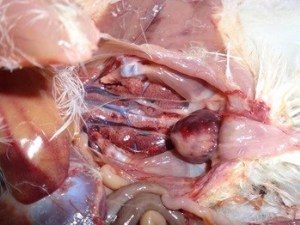by Dr. Amandeep Singh
Etiology or causative agent
IBD is caused by a birnavirus (infectious bursal disease virus; IBDV) that is most readily isolated from the bursa of Fabricius but may be isolated from other organs.
Transmission
It is shed in the feces and transferred from house to house by fomites. It is very stable and difficult to eradicate from premises.
Symptoms
The birds become anorectic.
Bloody diarrhea with accumulation of fecal material around the vent.
Eggs are malformed in laying birds.
The birds body weight severely hampers
Edema under skin of the thighs and breast and bird is not able to walk.
Clinical Findings
Infections may be subclinical or clinical.
Infections before 3 wk of age are usually subclinical.
Chickens are most susceptible to clinical disease at 3–6 wk of age when immature B cells populate the bursa and maternal immunity has waned.
Early subclinical infections are the most important form of the disease because of economic losses.
They cause severe, long-lasting immunosuppression due to destruction of immature lymphocytes in the bursa of Fabricius, thymus, and spleen.
Chickens immunosuppressed by early IBDV infections do not respond well to vaccination and are predisposed to infections with normally nonpathogenic viruses and bacteria.
In clinical infections, onset of the disease occurs after an incubation of 3–4 days.
Chickens may exhibit severe prostration, incoordination, watery diarrhea, soiled vent feathers, vent picking, and inflammation of the cloaca.
Flock morbidity is typically 100%, and mortality can range from 5%–20%.
Recovery occurs in <1 wk, and broiler weight gain is delayed by 3–5 days.

Treatment
There is no treatment.
Any broad spectrum antibiotic like enrofloxacin, levofloxacin, ciprofloxacin can be used to prevent secondary bacterial infections.
Vitamin supplements are also advised in this case.
Control
Rigorous disinfection of contaminated farms after depopulation has achieved limited success.
Live vaccines of varying low pathogenicity can be administered by eye drop, drinking water, or SC routes at 1–21 days of age generally given at 14 days in broilers.
Vectored vaccines that express the IBDV VP2 protein in herpesvirus of turkeys (HVT) can be used in ovo or at hatch.
Breeder flocks should be vaccinated one or more times during the growing period, first with a live vaccine and again just before egg production with an oil-adjuvanted, inactivated vaccine.
Gumboro Vaccine, to be given at 14 days in Indian conditions in broilers


